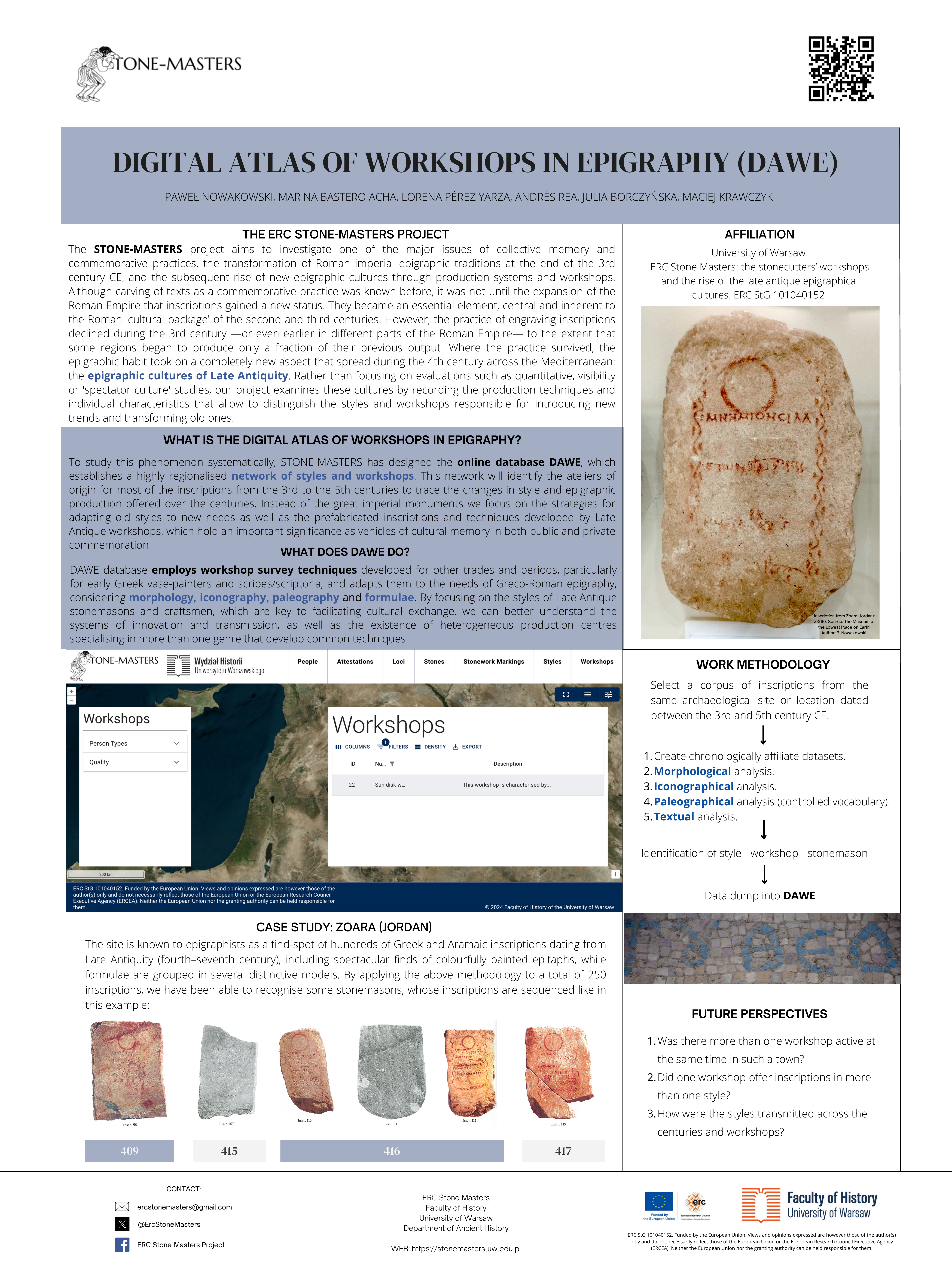Workshop 8 posters
Digital poster session
The Epigraphy.info VIII workshop will host poster session dedicated to the presentation of new and ongoing projects in the field of Digital Epigraphy. The poster session will be held in person, but also offer the possibility to present your poster virtually on the Epigraphy.info website during the workshop (where they will also remain publicly afterwards).
See all posters on Epigraphy.info GitHub
If you have any questions, please do not hesitate to contact the Epigraphy.info committee (info@epigraphy.info).
List of posters:
- Federico Aurora (Oslo): Integration and collaboration in Epigraphy: EpiDoc-export/import function for Database of Mycenaean at Oslo – DAMOS See poster
- Emine Bilgiç Kavak, Nurşah Çokbankir Şengül (Sakarya): Digitization of Inscriptions in the Isparta Yalvaç Archaeology Museum
- Andrea Brunello, Alessandro Locaputo, Stefano Magnani, Davide Redaelli, Giuseppe Serra (Udine): AI-aided analysis and restoration of late-antique Christian epigraphs (LACUNAE)
- Elena Duce Pastor (Madrid): Digital Epigraphy and Twitter: a proposal of public History for master students See poster
- Marta Fogagnolo (Bologna): Writing on more than one face (in Didyma and Miletus): an epigraphic database (EFES) See poster
- Aliénor Genety (Lyon): Épigraphie latine numérique de Césarée de Maurétanie : une recherche sur les données et les métadonnées d’un groupe de monuments funéraires (Ier siècle avant J.-C. au IIIe siècle après J.-C.) See poster
- Petra Heřmánková (Mainz/Aarhus), Jonathan Prag (Oxford), Imran Asif (Oxford), Marietta Horster (Mainz): FAIR – Epigraphic vocabulary See poster
- Estelle Ingrand-Varenne (Poitiers), Michèle Brunet (Lyon), Damien Strzelecki (Lyon): Epigraphy in the Biblissima+ project See poster
- Christoph Klose (Berlin): Community Cluster: “Objects as Information Carriers” (NFDI4Objects) See poster
- Winfried Kumpitsch, Wolfgang Spickermann (Graz): Celtic Divine Names in Latin Inscriptions of the Military Zone in Germania Superior on the Left Bank of the River Rhine See poster
- Lorena Pérez Yarza (Warsaw), José Carlos López Gómez, Jaime Alvar Ezquerra, Beatriz Paneda Murcia, Pablo Rodriguez Valdés, Blanca Rabazas Rubio (Malaga): Specialized databases on cults of the Greco-Roman worlds: Magna Mater, Mithras and Isis
- Martyna Swierk (Warsaw): Individualism and the Community Facing the Cultural Changes: EPIDENTITY Project
- Tatiana Tommasi (Venezia): Sacred inscriptions from the Venetia et Histria region published by Ludovico Antonio Muratori in his Novus thesaurus veterum inscriptionum (1739-1742) See poster
- Lorena Pérez Yarza, Marina Bastero Acha, Pawel Nowakowski, Julia Borczynska, Andrés Rea, Maciej Krawczy (Warsaw): Digital Atlas of Workshops in Epigraphy, DAWE See poster
1. Federico Aurora (Oslo): Integration and collaboration in Epigraphy: EpiDoc-export/import function for Database of Mycenaean at Oslo – DAMOS
Contact: federico.aurora@ub.uio.no
Abstract:
DAMOS - Database of Mycenaean at Oslo contains annotated transcriptions of all the published Mycenaean texts. The data is stored in a relational (MariaDB) database and can be searched and browsed through an online graphic user interface https://damos.hf.uio.no/. The present project deals with developing the possibility to export and import data from and to DAMOS in the EpiDoc format with the aim to: 1) integrate the data from DAMOS into the larger landscape of Latin and Greek documentary sources, making them reusable in other databases; 2) simplify the process of updating the texts on the occasion of new editions and new discoveries: the new import function will provide a much better workflow and, crucially, support collaboration in the field, as it will be possible for researchers to create and submit a new edition of a text without needing direct access to the database. EpiDoc-XML constitutes also a sustainable alternative for the long-term storage of the data in DAMOS. The project is funded by and developed in collaboration with Humit - Centre for digital development at the Faculty of Humanities of the University of Oslo. The funding application was kindly supported by the Epigraphy.info Funding Working Group and Steering Committee.
Click here to see the full Poster 1 (PDF)
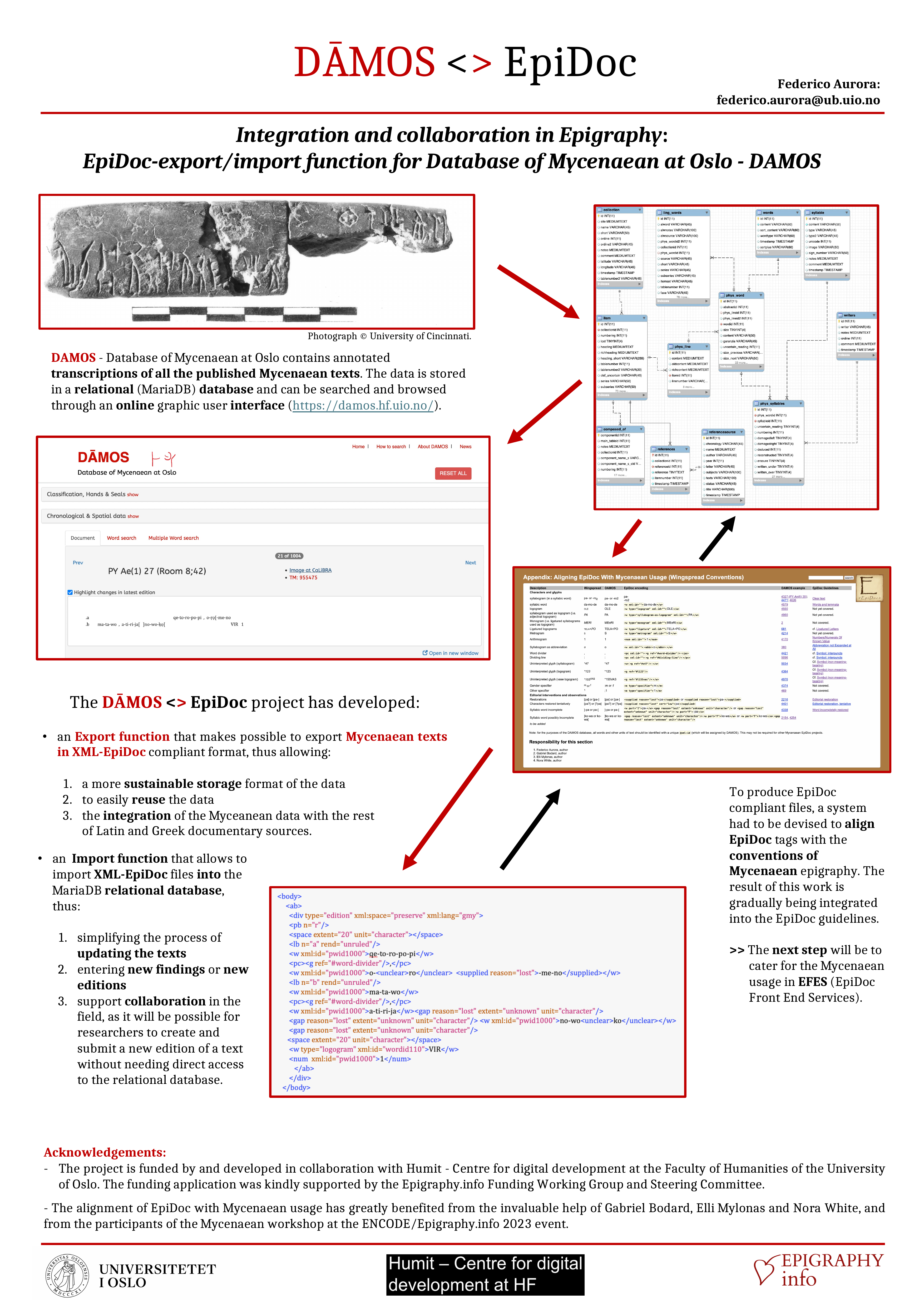
4. Elena Duce Pastor (Madrid): Digital Epigraphy and Twitter: a proposal of public History for master students
Contact: elena.duce@uam.es
Abstract:
In this poster, I will present the improvements of the Project with the master students of the subject. The Bronze Age in the Mediterranean: Minoans and Mycenaeans which is part of the interuniversity Master of Ancient History and Sciences of the Antiquity, held in the Autonoma and Complutense Universities (Madrid, Spain). In this period, the tablets of Linear B are essential to understanding the dynamics of the society. Nevertheless, the students’ previous knowledge is scarce in epigraphical resources. Thus, digital tools for this period, the DAMOS database of Oslo, based on digital epigraphy and NESTOR for bibliographical resources have helped us to create a service-learning Project based on public History using Twitter. Every student had to work with a Linear B tablet and create a thread on Twitter linking with epigraphic digital Databases. Last year, the Project was successful and this academic year we have included some innovations. Concretely, we have improved the Project with digital epigraphy training sessions to focus more on digital epigraphic resources and to promote significant learning in the students. With the help of Cristina de la Escosura, we have amplified the number of digital epigraphy resources that students use in other subjects. This proposal aims to present the main innovations and receive feedback for future academic years.
Click here to see the full Poster 4 (PDF)
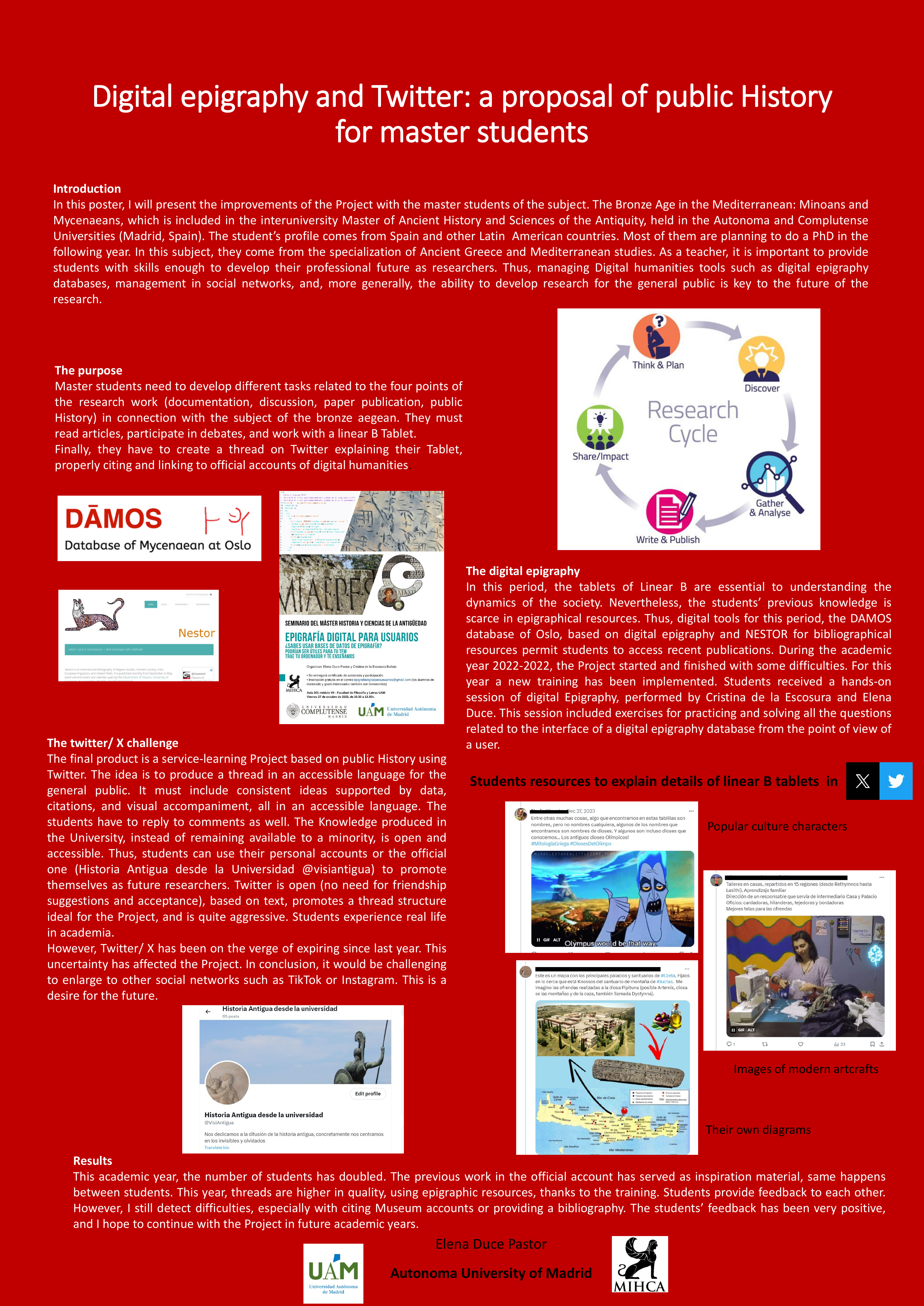
5. Marta Fogagnolo (Bologna): Writing on more than one face (in Didyma and Miletus): an epigraphic database (EFES)
Contact: marta.fogagnolo2@unibo.it
Abstract:
The poster aims to present a database published in EFES (EpiDoc Front-End Services) and encoded in EpiDoc-XML, which collects epigraphic supports inscribed on more than one face from Didyma and Miletus (57 records). The database examines a specific case study due to the huge number of supports with these features, but is intended to be implemented in the framework of my post-doctoral project ‘Writing on more than one face: historical, textual and material aspects of a Greek epigraphic practice’ (Department of History and Cultures, University of Bologna). The project aims to collect in an organic and reasoned way (through historical, philological-textual, and archaeological analysis) the evidence of the use and reuse of stone for Greek, or bilingual, epigraphic texts on more than one writing face. In the process of encoding the epigraphic material, a semantic-digital analysis has also been conducted with the aim of implementing the Guidelines for the digital encoding of epigraphic texts specifically concerning the markup of structural textual phenomena both in the text and in the metadata. What is strongly desirable is to bring these topics to the discussion of the EpiDoc and epigraphy.info Community, raising problems and suggesting new markup to encode these features.
Click here to see the full Poster 5 (PNG)
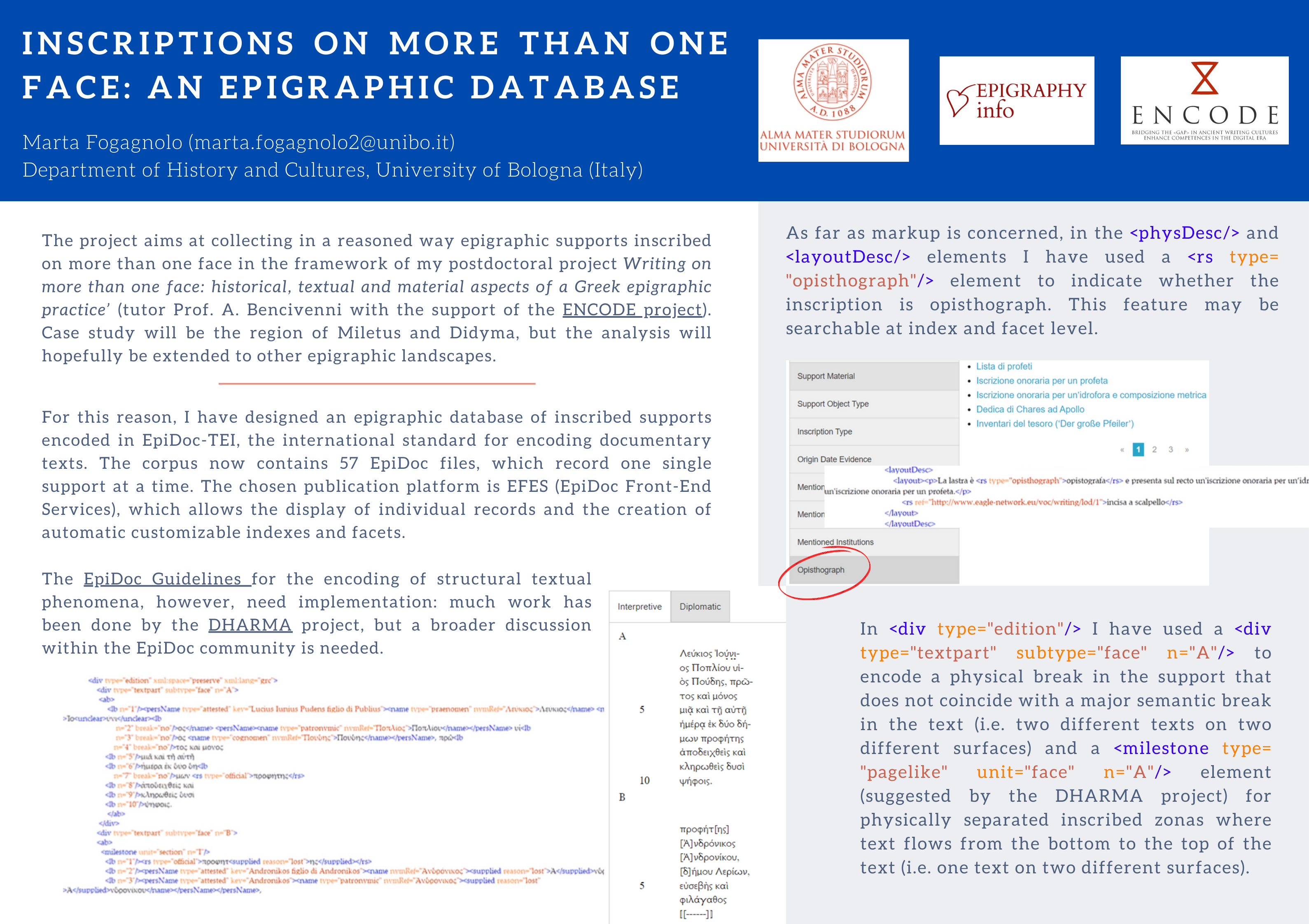
6. Aliénor Genety (Lyon): Épigraphie latine numérique de Césarée de Maurétanie : une recherche sur les données et les métadonnées d’un groupe de monuments funéraires (Ier siècle avant J.-C. au IIIe siècle après J.-C.)
Contact: alienor.genety@univ-lyon3.fr
Abstract:
Mon sujet de thèse s’intitule Épigraphie latine numérique de Césarée de Maurétanie : une recherche sur les données et les métadonnées d’un groupe de monuments funéraires (Ier siècle avant J.-C. au IIIe siècle après J.-C.). Ce dernier porte sur l’étude des inscriptions, issues de nécropoles situées à l’ouest de la ville de Cherchell (Algérie). L’étude des inscriptions devrait permettre de cerner l’histoire de ce secteur et les différentes dynamiques d’implantation des nécropoles, le profil sociologique des usagers et l’évolution des pratiques et des techniques épigraphiques (formulaire, paléographie, matériaux, etc.). L’analyse complète de ce corpus, lie intrinsèquement pratique épigraphique et pratique numérique, l’un permettant de nourrir l’autre et inversement. Chaque notice est pensée et enrichie par un encodage en XML-TEI, pour faire face aux problématiques qui m’intéressent, à savoir le croisement du traitement du texte inscrit et du monument comme porteur de cette inscription. Le but de mon travail est de créer un certain nombre de modules portant sur les formulaires (Diis Manibus, etc.) mais également sur la paléographie même des caractères. Le traitement de ce corpus épigraphique est à voir comme un « programme » rédactionnel reposant sur une réflexion sur la technique d’écriture elle-même (taille et forme des caractères, usage du support, etc.) afin de déterminer si ces éléments peuvent apporter un éclairage nouveau à l’histoire des inscriptions de Cherchell, par exemple en créant des « mises en série » nouvelles pouvant poser la question d’un même atelier, ou d’un même groupe social.
Click here to see the full Poster 6 (PDF)

7. Petra Heřmánková (Mainz/Aarhus), Jonathan Prag (Oxford), Imran Asif (Oxford), Marietta Horster (Mainz): FAIR – Epigraphic vocabulary
Contact: petra.hermankova@uni-mainz.de
Abstract:
The creation of an updated controlled epigraphic vocabulary has been identified by the community as essential to moving forward towards the best practice of FAIR and Open Science in epigraphy (Tupman 2021; Heřmánková et al. 2022). The proposed FAIR epigraphic controlled vocabularies present a consolidation of work conducted by the EAGLE Europeana Project in 2013-2016 (Liuzzo et al. 2013; Liuzzo 2015; Liuzzo and Evangelisti 2021) and an alignment of current standards of partner projects of the FAIR Epigraphy Project https://inscriptiones.org/. This ‘bottom-up’ application employs a multifaceted hierarchic categorization system allowing for multiple conceptual approaches while recognizing the complex and multilingual nature of inscriptions and the historiography of the discipline. Furthermore, the vocabulary adheres to the principles of FAIR data, emphasizing Findability, Accessibility, Interoperability, and Reusability as their core principles (Wilkinson et al. 2016). This means that researchers can easily locate and access relevant terms, ensuring that the vocabulary is user-friendly and widely applicable. Crucially, the controlled vocabulary is made available as a Linked Open Data (LOD) resource, accessible online with stable Uniform Resource Identifiers (URIs), hosted by the FAIR Epigraphy Project and the University of Oxford. This approach facilitates efficient collaboration, linking, and cross-referencing, enabling researchers to build upon each other’s work and explore epigraphy in a structured and accessible manner across project boundaries. Overall, this initiative enhances the research landscape in epigraphy by fostering cooperation and providing a reliable and standardized resource for scholars in the field. We present the first stage of the creation of the FAIR Epigraphic vocabularies: the type of inscription aligned across multiple projects, with a simple hierarchic order, multiple examples from partner projects and a detailed description of individual types. We are opening an invitation to discuss our proposed structure, its viability and robustness for long-term use within the digital epigraphic community.
Click here to see the full Poster 7 (PDF)
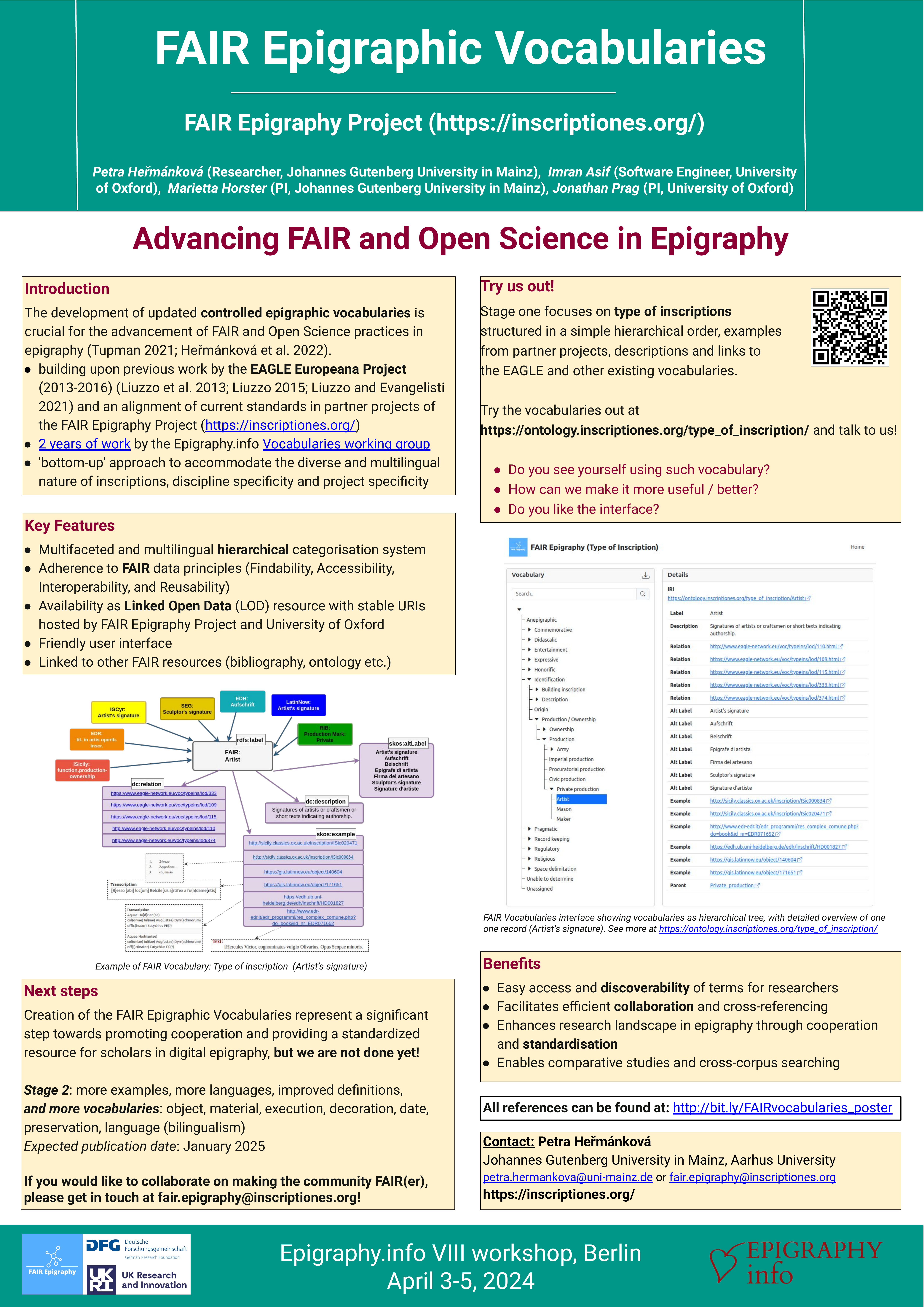
Estelle Ingrand-Varenne (Poitiers), Michèle Brunet (Lyon), Damien Strzelecki (Lyon): Epigraphy in the Biblissima+ project
Abstract:
Biblissima+ https://projet.biblissima.fr/fr is a multi-site digital infrastructure for primary research and services dedicated to the history of the transmission of historical texts, from the first Mesopotamian clay tablets 3,000 years ago to the first printed books, in all media and scripts. Biblissima+ is the place at the national level where all the data involved in the history of the transmission and study of ancient written cultures are processed and made interoperable. Biblissima+ concerns all heritage collections that transmit ancient texts, including archaeological sources, seals and coins, as well as the archives of modern scholars and contemporary researchers. The “Cluster 5a” brings together projects that apply TEI to epigraphic documents from Antiquity, the Middle Ages and the modern period, which is a first in France for this discipline. This working group is giving priority to the generic rules of digital epigraphy by compiling a thesaurus for the discipline with the OpenTheso tools, and to modelling in order to create a “format pivot” for searching epigraphic data via the Biblissima+ Portal.
The poster will present the overall project and the first steps of the Cluster 5a TEI and epigraphy.
Click here to see the full Poster 8 (PDF)
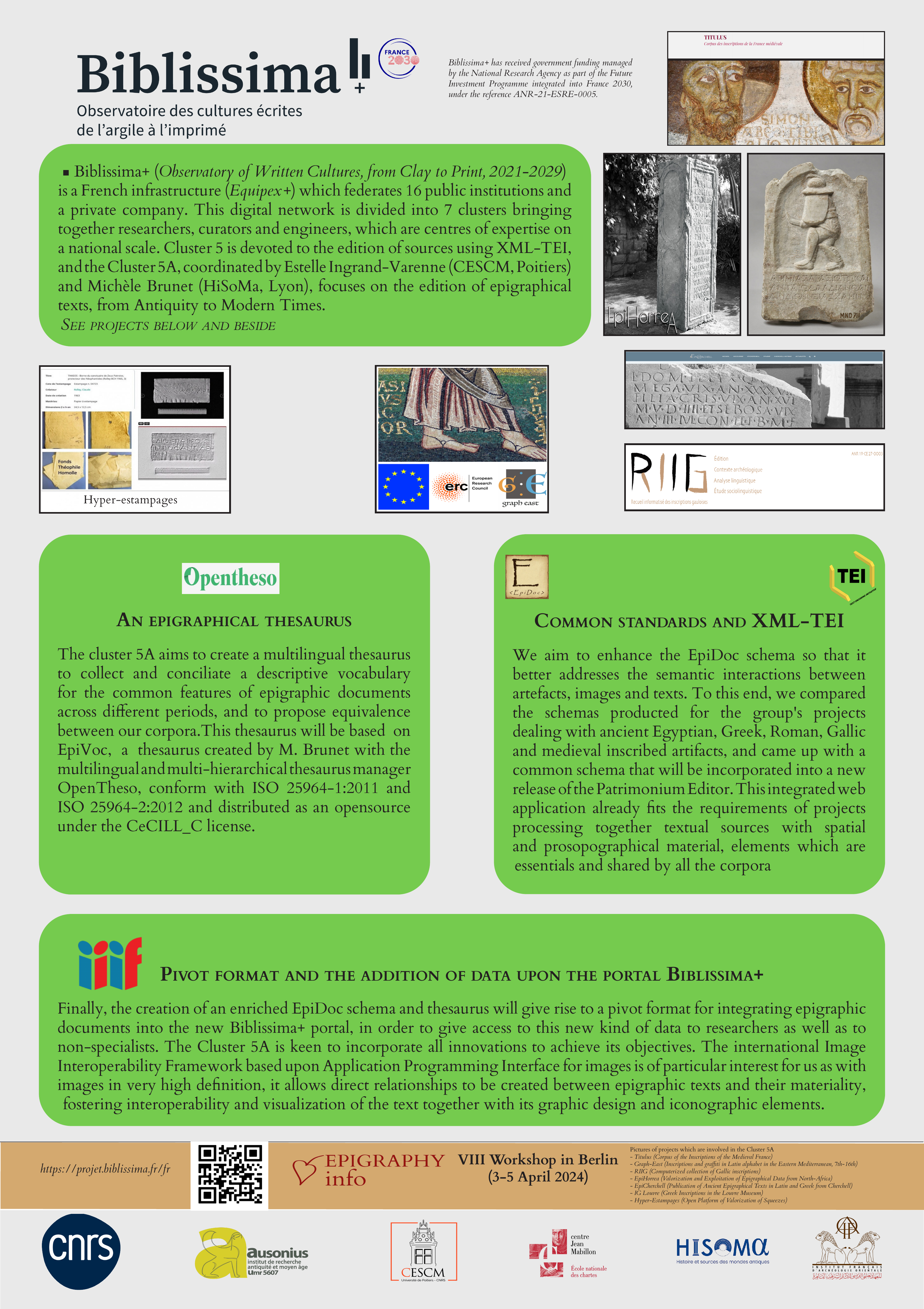
9. Christoph Klose (Berlin): Community Cluster: “Objects as Information Carriers” (NFDI4Objects)
Contact: c.klose@smb.spk-berlin.de
Abstract:
The Community Cluster “Objects as Information Carriers” is part of the DFG-funded initiative NFDI4Objects (designated spokespersons Ulrike Ehmig (Berlin-Brandenburg Academy of Sciences and Humanities, CIL) and Bernhard Weisser (Berlin State Museums, Coin Cabinet). The cluster aims to establish an open community representing both collecting and editing institutions as well as researchers from all disciplines who deal with written artefacts as material remains of human history. The cluster focuses on objects as carriers of (semantic) information that can be expressed in signs, letters or texts. The overarching goal is to model the complex relationships between the materiality of an object and the semantic information it contains from the perspective of research data management. In a process driven by the members of the community, needs and goals in this area of research and documentation are therefore identified. These may include topics such as: ∙ Improving the interoperability of existing data collections and data discovery services ∙ Transfer of high-quality research standards from reference works to the semantic web ∙ Qualification of research data through generally accepted and semantically agreed authority files, community-developed vocabularies and ontologies at the interface between textual, visual and (geo-)spatial information ∙ A first goal could be the creation of a transdisciplinary catalogue of existing digital repositories and databases. Once the objectives have been defined by the community, they are processed by Temporary Working Groups. Thus we expressively welcome experts, researchers and collecting institutions from the epigraphic field to join the community cluster in order to contribute to the creation of a future-oriented research data infrastructure.
Click here to see the full Poster 9 (PDF)
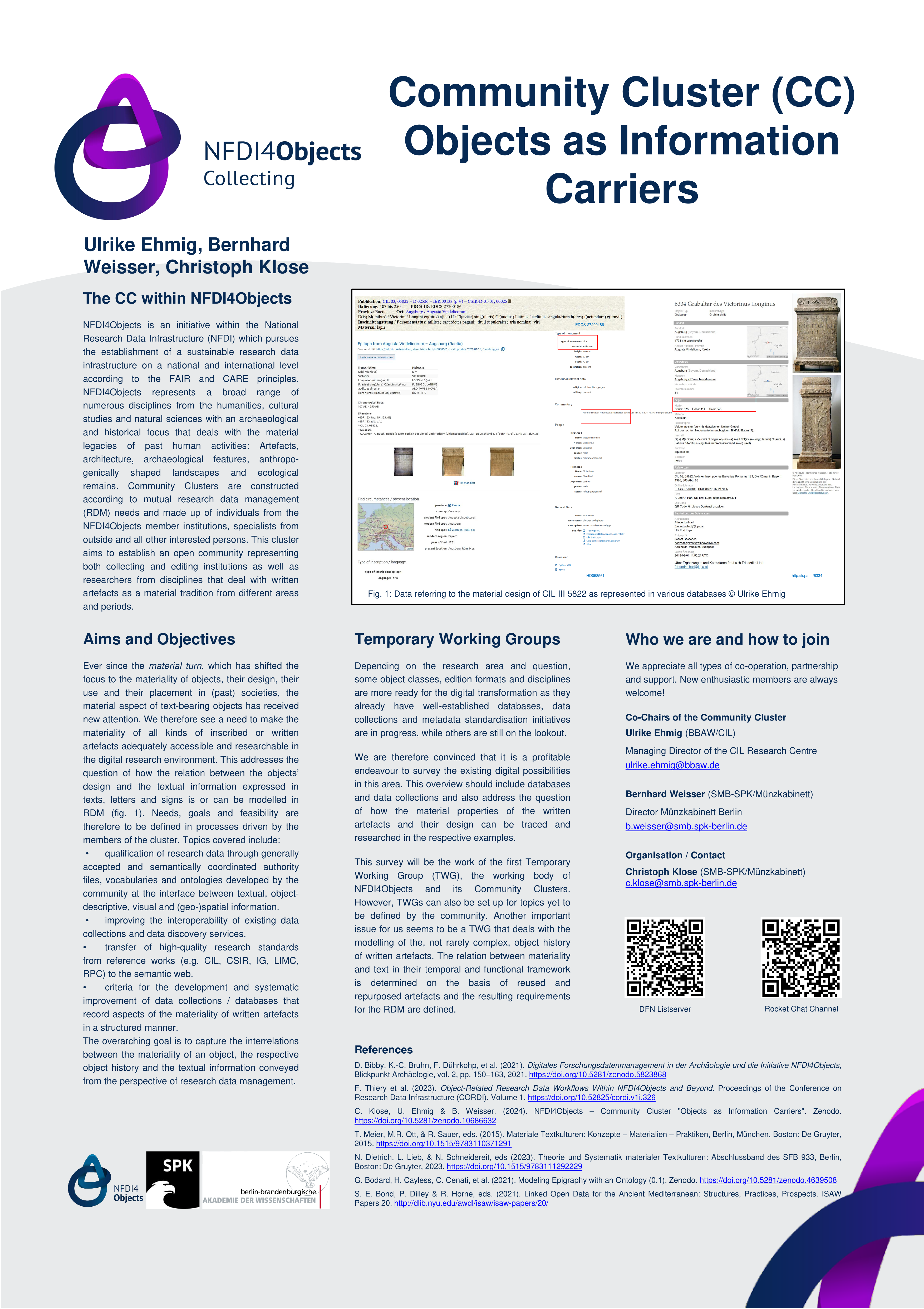
Winfried Kumpitsch, Wolfgang Spickermann (Graz): Celtic Divine Names in Latin Inscriptions of the Military Zone in Germania Superior on the Left Bank of the River Rhine
Contact: winfried.kumpitsch@uni-graz.at
https://gams.uni-graz.at/fercan
Abstract:
The above-named project is part of the F.E.R.C.AN. (FONTES EPIGRAPHICI RELIGIONVM CELTICARVM ANTIQVARVM) project of the Österreichische Akademie der Wissenschaften (ÖAW). It is a follow up project to “Celtic Divine Names in the Inscriptions of the Roman Province Germania Inferior A Case Study on Religion in the Context of Cultural Contacts and Cultural Transfer” which did the same research in the whole of Germania Inferior. The project’s objective is the comprehensive collection, evaluation and re-edition of epigraphic monuments with Celtic divine names in the military zone of Germania Superior on the right and left bank of the Rhine. The project not only applies new computer-assisted techniques for the (re-)reading of inscriptions in bad conditions, but also publishes the results as a digital inscription edition on GAMS (Geisteswissenschaftliches Asset Management System) of the Austrian Centre for Digital Humanities (ZIM) at the University of Graz. In order to improve the workflow of this digital edition, the PATRIMONIVM editor has been adapted to facilitate data acquisition for the digital edition of inscriptions, forming a modular, customisable and integrated web application for the management of epigraphic corpora, based on the eXist-db platform. With the poster presentation we want to demonstrate the advantages of the PATRIMONIVM editor when curating a digital inscription edition.
Click here to see the full Poster 10 (PDF)

13. Tatiana Tommasi (Venezia): Sacred inscriptions from the Venetia et Histria region published by Ludovico Antonio Muratori in his Novus thesaurus veterum inscriptionum (1739-1742)
Contact: tatiana.tommasi@unive.it
Abstract:
My PhD project is dedicated to the study of the sacred inscriptions from the ancient Venetia et Histria region (Regio X), with particular attention to the handwritten tradition of epigraphic documents and to the potentialities offered by state-of-the-art digital technologies to study them. Digital technologies will be mainly applied for recovering the information contained in handwritten documents related to epigraphy (epigraphic manuscripts, but also epistolary exchanges) produced between the eighteenth and the nineteenth century, a fundamental period for the birth of the epigraphic discipline. As a case study, I will focus on the sacred inscriptions from the Venetia et Histria region published by Ludovico Antonio Muratori in his Novus thesaurus veterum inscriptionum (1739-1742) and recorded in the handwritten documents connected to the printed edition (especially the transcriptions of the epigraphic texts sent to Muratori by his contemporaries, who saw the inscriptions in person, now preserved in Modena, Biblioteca Estense Universitaria, Archivio Muratori). During the first part of my project, I will apply Handwritten Text Recognition technologies to the archival documents in order to create an annotated version of them and to improve their layout analysis. In the last phase of my research, I will produce an EpiDoc database of the sacred inscriptions from the Venetia et Histria region, enriching the EpiDoc records with the information retrieved from the epigraphic tradition, in order to create a connection with other epigraphic resources available online.
Click here to see the full Poster 13 (PDF)
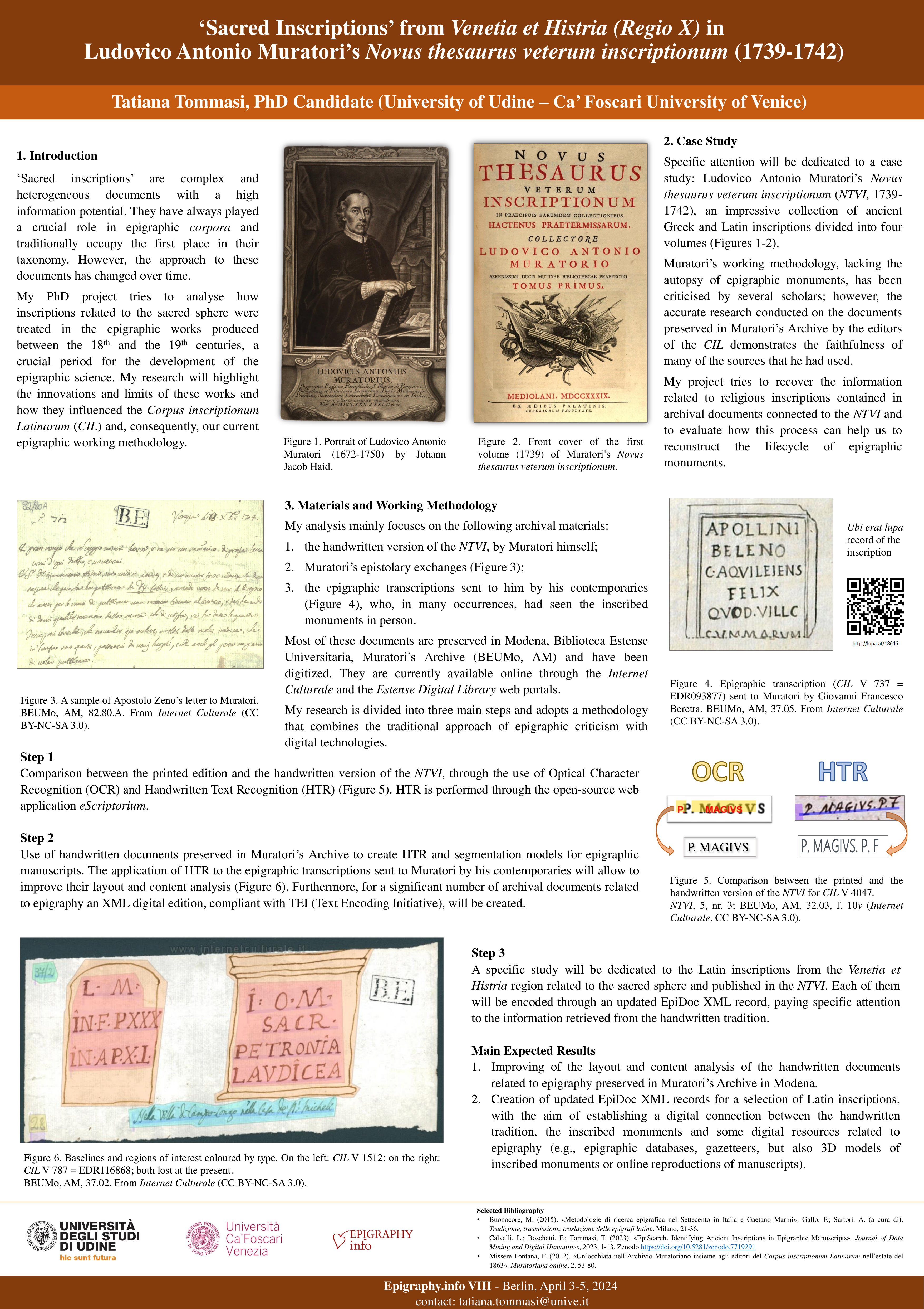
14. Lorena Pérez Yarza, Marina Bastero Acha, Pawel Nowakowski, Julia Borczynska, Andrés Rea, Maciej Krawczy (Warsaw): Digital Atlas of Workshops in Epigraphy, DAWE
Contact: m.bastero-acha@uw.edu.pl
Abstract:
DAWE is a digital database being developed as part of the ERC STONE-MASTERS project, collecting information on the stonemasons and artisans of Late Antiquity. Our approach views them as key players in facilitating cultural exchange from top to bottom, acting as cultural intermediaries between the elite and the general public during that period of transformation. Additionally, their prefabricated inscriptions (and therefore prefabricated goods in preindustrial societies) hold significant meaning as vehicles of cultural memory in both public and private commemoration. So far, epigraphists of the Roman period have had few instruments to draw upon for the purposes of pursuing synthetic workshop studies, and have been overwhelmingly captivated by other strands: the quantitative research, the study of the self-representation, the visibility of inscriptions, and the “viewers’ culture”. STONE-MASTERS argues, however, that a significant leap in our understanding can be achieved by establishing a highly regionalised network of workshops, which will identify the workshops of origin for most of the inscriptions from the 3rd to the 5th centuries and allow us to trace the changes in style and products offered by these workshops over the centuries. In order to achieve this goal, DAWE is utilising the workshop study techniques that have been developed for other crafts and eras, particularly early Greek vase painters and scribes/scriptoria, and tailoring them to fit the requirements of Graeco-Roman epigraphy.
Click here to see the full Poster 14 (PDF)
